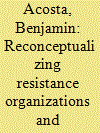|
|
|
Sort Order |
|
|
|
Items / Page
|
|
|
|
|
|
|
| Srl | Item |
| 1 |
ID:
188034


|
|
|
|
|
| Summary/Abstract |
In seeking to overthrow, reform, or separate from an existing political system, both violent and nonviolent resistance organizations emerge. A common finding shows that democracies face violent resistance more so than autocracies. Studied less remains the pattern of organizations using nonviolence in efforts to topple autocratic regimes. What explains these trends in conjunction with one another? I put forth a theory contending that exclusionary politics frames the organizational use of violence and nonviolence in resistance campaigns. To test hypotheses, I analyze an original dataset of over 500 resistance organizations (1940–2014). I complement the large-n tests by reviewing resistance organizations that formed amid Lebanon’s Civil War (1975–1990) and Cedar Revolution (2005) using field methods, qualitative contextualization, and process tracing. The results reveal that the relationship between the target political system and the degree of inclusion of a resistance organization’s constituent identity group helps explain the adoption of violent strategies.
|
|
|
|
|
|
|
|
|
|
|
|
|
|
|
|
| 2 |
ID:
167293


|
|
|
|
|
| Summary/Abstract |
In recent years, scholars of various forms of conflict involving revolutionary and militant organizations (such as terrorism, civil war, and nonviolent contestation) recognized that arbitrary organizational categories and typologies often leave large-N studies incomplete and biased. In moving away from nominal categorical boundaries that produce such selection biases and looking to a more generalized conception of resistance organizations, I constructed an original dataset that aims to bridge the gap between conflict literatures. Transcending traditional classifications, the Revolutionary and Militant Organizations dataset (REVMOD) consists of over 500 resistance organizations operative sometime between the years 1940 and 2014 and includes a diverse array of types of resistance organizations – many of which utilize a multitude of tactics, operate in various conflict contexts, and/or confront numerous target types. The dataset documents organizational attributes, allies, and adversaries at annual intervals (organization-years), making reliable time-series analyses possible. Tracking variables like organizational outcome-goal type and degree of achievement, political capacity, leader/s, constituent identity group, violence and demonstration levels, size, organization aliases, and several others, REVMOD breaks new ground in the collection of information on resistance organizations and can spur countless studies. A preliminary data analysis demonstrates that differences in organizational political capacity explain variation in resistance outcomes generally and in particular contexts such as civil war, terrorism, and nonviolent revolutions. REVMOD provides a unique opportunity to develop a new research paradigm for resistance studies that employs large-N empirical analyses to uncover generalities between different forms of political contention in the contemporary era, as well as to better understand why and how distinct resistance processes may produce specific outcomes.
|
|
|
|
|
|
|
|
|
|
|
|
|
|
|
|
|
|
|
|
|